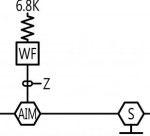So, this is a bit of thread drift, but...
Unless the devices are more than 12" wide, picture #2 would not make any sense, assuming these devices are hanging on a wall, because the minimum separation for feed and return is supposed to be 12" for vertical runs. However, to single devices, the code allows you to put the feed and return in the same pathway. This makes sense, since at worst if you break that path you lose only one device and apparently the committee felt that was a reasonable compromise. What you didn't illustrate is drop down to device 1, run directly across to device 2 and then go up again, which is what you might get if you came in the left side of the junction box the device is mounted on and then went out the right side of the box. You might consider that "pure" Class A. I should note that the distance between device 1 and device 2 has to be greater that 12" or you violate the spacing requirements.
There are additional exceptions and requirements, but I'd suggest you crack open NFPA 72 and meditate a little.





